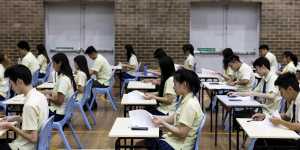A third of students at high-fee Moriah College were granted HSC disability provisions last year,as well as about one in four students at Reddam House,Wenona and Ascham,all independent schools. Yet,there were no applications from the socioeconomically disadvantaged Punchbowl Boys’ High School in Sydney’s south-west.
Disability provisions are costly as they often require extra or even private invigilators - who cost $27 an hour - as well as special equipment,complex planning and a team of assessors. The expense is borne by the publicly funded NSW Education Standards Authority (NESA).

The number of students claiming HSC disability provisions has been growing.Dominic Lorrimer
The provisions are designed to create a level playing field for students,and range from extra reading time to breaks,scribes and isolated rooms. A growing majority of applications are for psychological issues such as anxiety,while others are for medical or learning conditions.
High-fee schools often have staff available to help families navigate different kinds of applications,including HSC ones,while public schools have a lower staff-student ratio. Some disadvantaged families also fear there is a stigma attached to applying for disability provisions.
The independent sector represents an increasing share of applications for HSC disability provisions,rising from 12.7 per cent in 2017 to 16 per cent last year,ahead of the Catholic sector with 13 per cent in 2020 and public schools with 10 per cent.
However,state schools have a higher proportion of students with a funded adjustment under the disability loading scheme and more pupils with “substantial and extensive” loadings than other sectors,federal government figures show.
Five of the top 20 schools for total students gaining disability provisions in 2020 were government and the top four were private. Independent school applications are also least likely to be rejected.

Carol Taylor,a former chief executive of NESA who worked for the organisation for 30 years,said at least half a dozen reviews over many years have tried to address the disproportionate use of disability provisions.
She said the application and approval processes were rigorous,and students were not getting access to provisions they did not deserve. However,schools in lower socio-economic areas did not apply for them at the same rate as advantaged ones.
One issue was that families at some disadvantaged schools saw provisions as an admission that something was wrong with the student. They might also struggle with the process. At advantaged ones,parents and teachers understood how to navigate the system.
“It’s the cultural capital thing,and that impacts on education in all sorts of ways,” she said. “It’s a complex problem,it’s got all kinds of dimensions.”
The process was also costly for NESA,Ms Taylor said,as it had its own team to assess the applications,and it paid for the equipment,assistants and extra supervisors required if students needed more reading time or rest breaks.
Craig Petersen,the head of the Secondary Principals Council,said disability provisions could be a cultural issue within a school:in some,applications are sought-after while at others,there’s a stigma. But “if many of your peers are also receiving special provisions that if you don’t,there’s a potential for the fear that you’re somehow missing out,” he said.
However,high numbers of disability provisions made running the HSC “an absolute nightmare” for schools,Mr Petersen said. “Even if you take away what each sector is doing and who is paying for it,the more students you have on special provisions,the more complex the exercise,” he said.
A spokeswoman for NESA said students with provisions such as readers,scribes,rest break,extra time and anxiety disorders often did their exams in small groups,requiring their own supervisors. She said disability provisions represented a small but essential portion of the HSC budget.
“Over the past 18 months,NESA has been conducting workshops that aim to reach every school in NSW to provide on-the-ground advice and support to improve schools’ understanding of disability provisions,” she said.
“HSC disability provisions workshops aim to ensure all schools and school sectors know about and understand the program,and apply as needed.”
The chief executive of the Association of Independent Schools of NSW,Geoff Newcombe,said the program was open to all sectors. “AISNSW is not in a position to comment on why there are not more applications from schools in other sectors,” he said.
“All applications must be supported by documented evidence and there is a rigorous process for applications to be approved by NESA.”
The Morning Edition newsletter is our guide to the day’s most important and interesting stories,analysis and insights.Sign up.